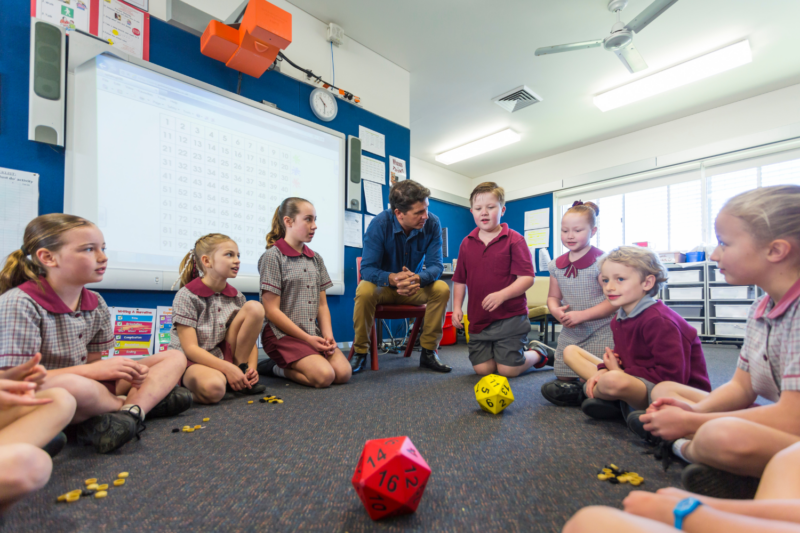Insights
Purposeful Play in PreK-2nd Grade Math
“Let them play!” is the current cry of many in education and psychology. So how can play be purposeful and beneficial to students, and how can teachers incorporate it into their PreK-2nd grade math classroom?
When many hear the word “play,” they may think of kids enjoying a free-for-all with the supervision of an adult for safety and keeping the peace when squabbles arise. That is not what the current push within education is calling for though. Purposeful play is an instructional strategy between direct instruction and free play. It uses the basic principles of play (enjoyment, creativity and imagination, sharing, exploration, etc.) in a way that leads to an increase in educational skills and understanding.
Studies also show how it improves Executive Functioning and Self-Regulation Skills, both vitally important within a child’s development. Teachers are guides within this process, mindfully staying within that thin line between direct instruction and free play. This is made possible through intentional, well-designed learning environments.
What are the benefits of purposeful play? Glad you asked.
It can improve student engagement and motivation because kids are naturally drawn toward playful activities. Incorporating purposeful play into your classroom will keep learning fun for them. It promotes creativity and imagination, another key aspect of play by which students are easily motivated.
Purposeful play enhances problem-solving skills. It encourages students to ask questions, consider possible outcomes, and make decisions. These are all vital skills within math instruction and life as a whole.
When thinking of play, you often visualize kids playing together, right? The community aspect is a crucial part of play because they are learning to communicate ideas, collaborate, share, and take turns. All of these benefits are also significant within purposeful play.
We all know how easily free play among students can sometimes lead to arguments and hurt feelings. A teacher’s guidance and interaction within purposeful play is a way to decrease those occurrences (keeping in mind that kids will still be kids and no one is perfect). This guidance, in turn, creates a safe place for students to voice their questions and ideas, experiment with possible outcomes, and learn new skills. All of these can build confidence within a student.
Learning mathematical concepts can occur through a variety of methods. Purposeful play is one method that allows students to bridge the gap between the abstract and the concrete. The following are examples of how to use purposeful play within your PreK-2 classroom. They can be adapted for use as whole-class or individual student activities.
Examples:
- Manipulatives are wonderful tools for purposeful play. Since many have been created for math instruction, they are already geared toward mathematical skills and concepts, such as counting, sorting, shapes, size, patterns, etc.
- Puzzles promote problem-solving, the use of fine motor skills, as well as visual/spatial skills. These are also a great way to increase focus and encourage perseverance.
- Create visual patterns using items of varying colors and shapes like tangrams, stickers, pieces of construction paper, sticky notes, and wooden or plastic shapes and animals.
- Use dice, decks of traditional playing cards, or dominoes to practice mathematical concepts and skills like greater than/less than, ordering numbers, addition, subtraction, etc.
- Explore concepts associated with size by providing students with various objects and tools to measure and compare. Ideas for objects include blocks, small rocks, rice, and toys. Consider providing tools for them to experiment with such as balance scales (both analog and digital in various forms), measuring cups, a measuring tape, and rulers.
- To practice money skills, students can use a play cash register, money, and plastic food items. Don’t forget to provide shopping baskets or bags!
- Games that are designed to incorporate math concepts add another fun aspect to learning through purposeful play. Ideas include math bingo, jeopardy, and memory match games. Gross motor skills are also used in games like Giant Step, LeapFrog, Math Path, and Four Corners.
However you choose to incorporate purposeful play within your classroom, remember to focus on those two words: purposeful and play. What purpose or objective are you striving to meet with the activity, and is it enjoyable enough to be considered play? Also, don’t forget to take the time to enjoy playing with your students. After all, we’re still kids at heart, right?
For digital manipulatives, check out our Stepping Stones curriculum. We’ve partnered with Brainingcamp, a cutting-edge digital manipulatives provider, to provide mathematics designed to make math meaningful, enjoyable, and accessible for all learners.



